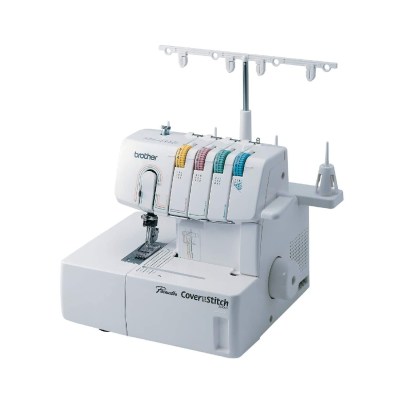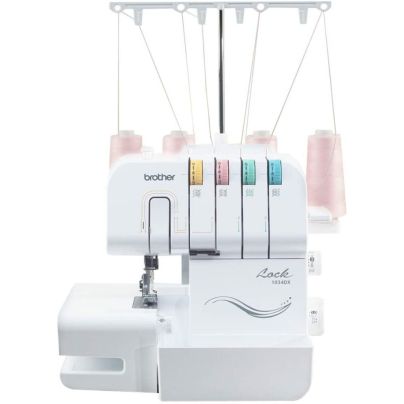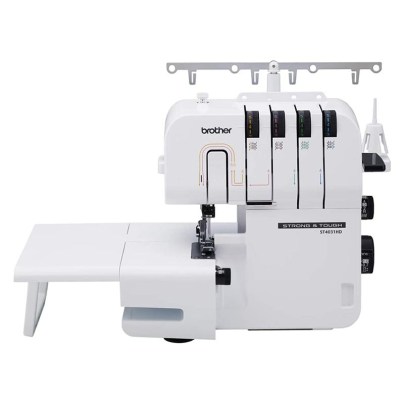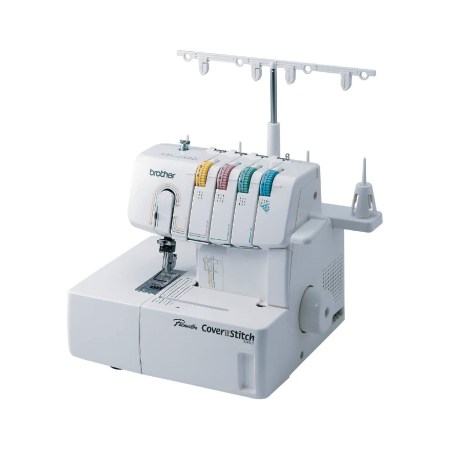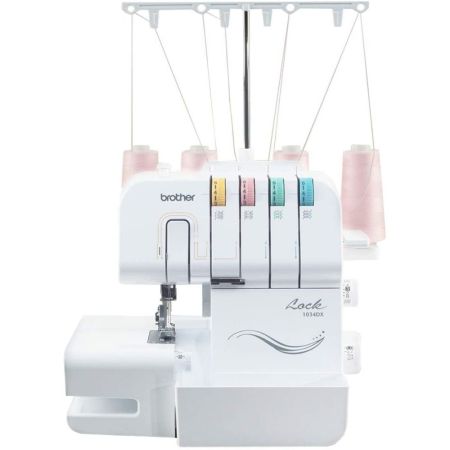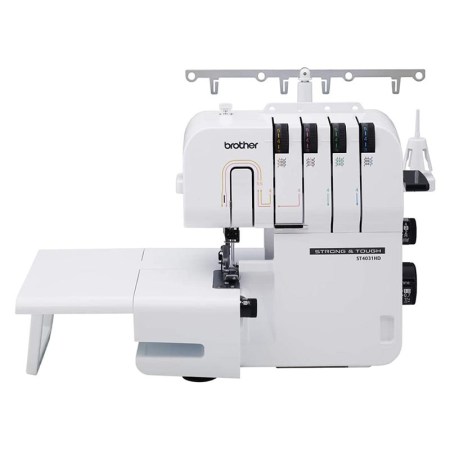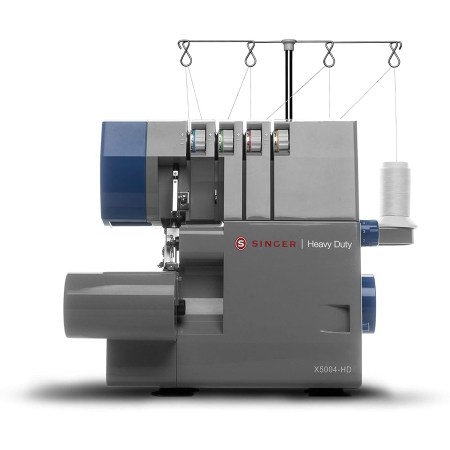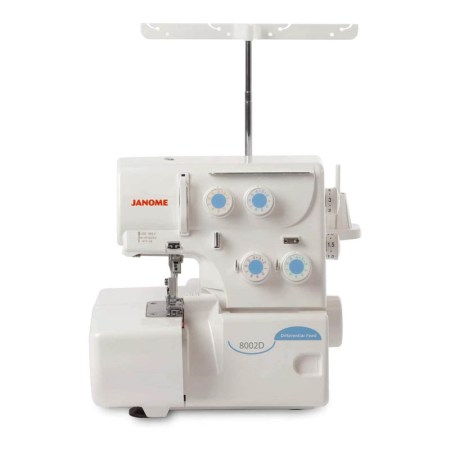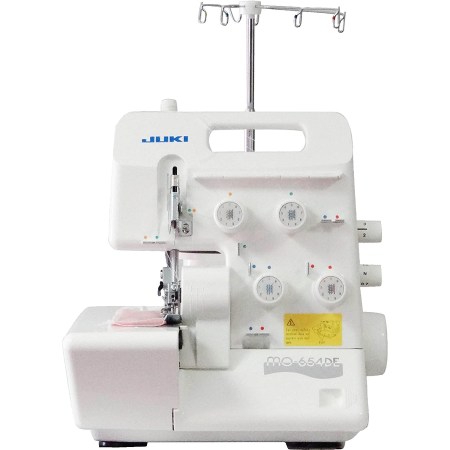We may earn revenue from the products available on this page and participate in affiliate programs. Learn More ›
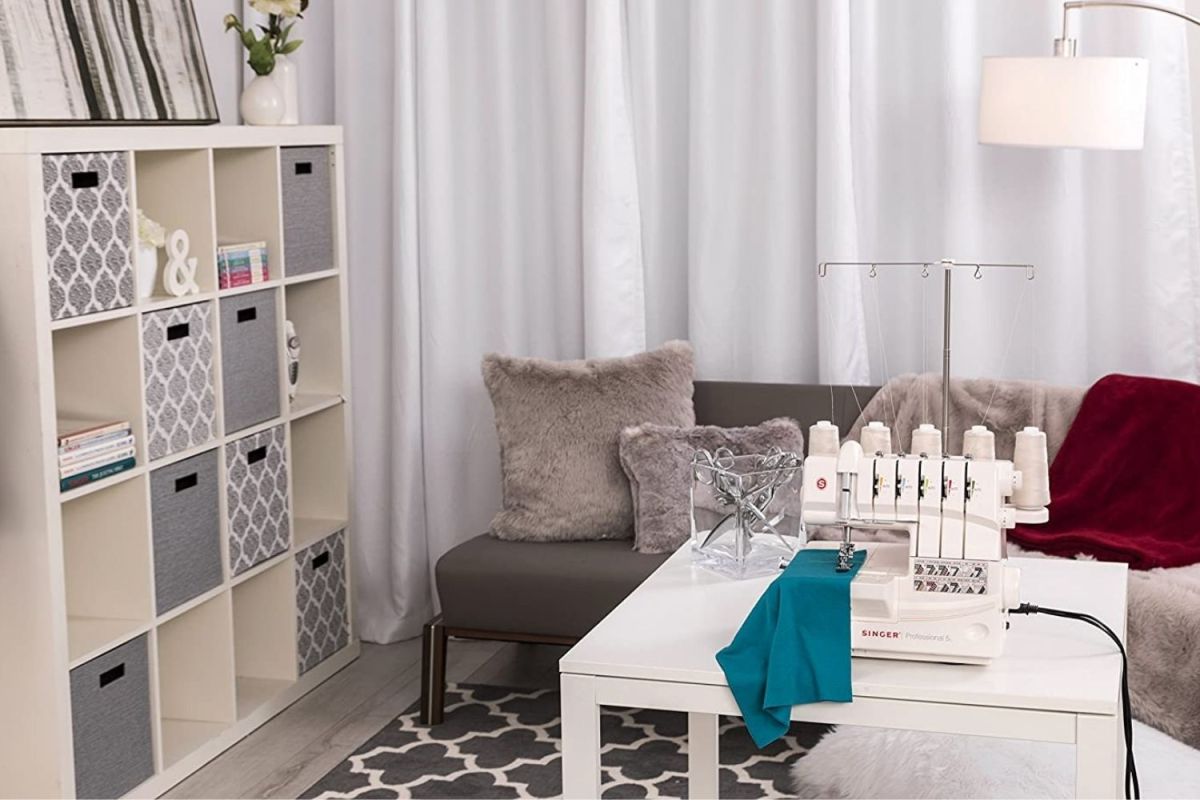
The best sergers machines offer a few key advantages over conventional sewing machines. They create stronger, more durable seams, hems, and edges, which makes them useful in commercial garment production. Moreover, they not only deliver professional results, but they’re also faster than traditional sewing machines. They can create multi-thread stitches that give garments and other fabrics extra stretch.
These machines are also better at sewing stretchable fabrics.
Unlike a sewing machine, sergers have multiple bobbins and threads. Keep reading to learn some shopping considerations and top picks for your next sewing project.
- BEST OVERALL: Brother 2340CV Coverstitch Serger
- BEST BANG FOR THE BUCK: Brother 1034DX ¾ Thread Serger
- UPGRADE PICK: Brother ST4031HD Strong & Tough ¾ Thread Serger
- MOST VERSATILE: Singer X5004-HD Heavy Duty Overlock Machine
- BEST FOR BEGINNERS: Janome 8002D Serger Sewing Machine
- BEST PORTABLE: Juki MO-654DE Portable Serger
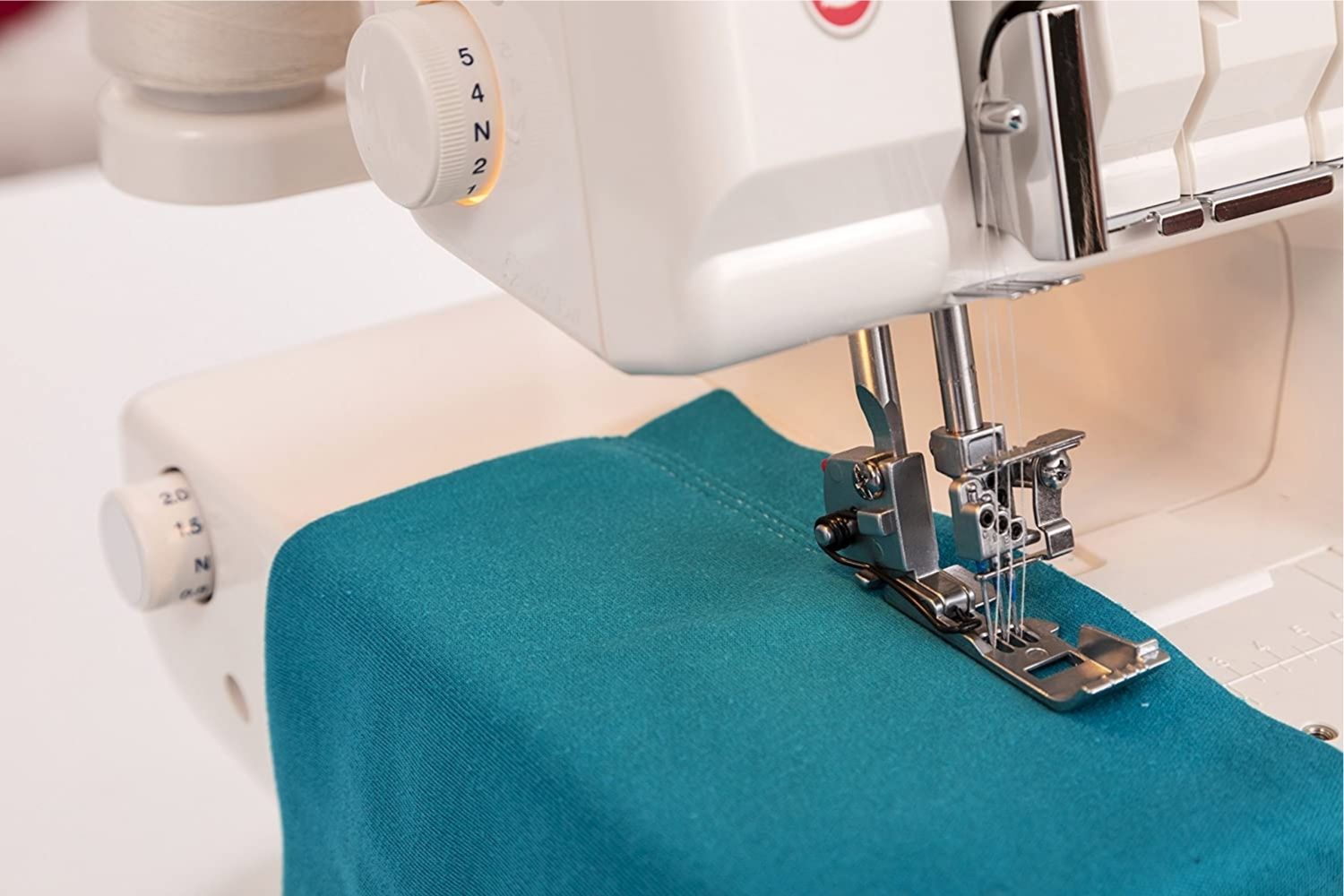
How We Chose the Best Sergers
We researched the most sought-after serger sewing machines in their respective categories. The best models are determined by their stitch types, size and weight, motor speed, ease of use, and the other special features included in top brands.
For sewers with various needs, we included serger sewing machines that offer one-, two-, three-, four-stitch options as well as coverstitches that can be stitched at rates of 1,100 to 1,500 stitches per minute. Many of these sergers include color-coded threading systems, easily adjustable stitch lengths, widths, and trim traps, and even foot attachments, making them easy to use for both beginners and pros.
Select serger sewing machines also come with LED lights, safety switches, wide table surfaces, workbooks, and accessories, such as fabric scissors and tweezers, for added convenience. To ensure you can use these sergers anywhere in your home or workshop, many are lightweight and compact enough to fit on desks, sewing tables, or even shelves for storage.
Our Top Picks
Each of our top picks is manufactured by a reputable brand and meets all our shopping considerations. Pull up your sewing chair and keep reading.
Best Overall
Brother 2340CV Coverstitch Serger
See ItThe Brother 2340CV coverstitch serger offers multiple coverstitch options for various types of fabric. The machine features color-coded threading, and sewers can adjust the stitch length easily. It comes with a variety of accessories, including numerous foot attachments, tweezers, and an accessory bag.
Unlike other machines, the Brother 2340CV doesn’t cut the excess fabric off the seams while sewing, so it can even create circular hems. It’s speedy and easy to use. However, the tension release may be a bit challenging to operate.
Product Specs
- Stitch type(s): 2, 3, 4, and coverstitches
- Size: 14 inches high by 12.9 inches wide by 15 inches deep
- Motor speed: 1,100 stitches per minute
- Ease of use: Easy
Pros
- Releasing fabric is made very easy with automatic thread pulling and self-knotting mechanism
- Compact and lightweight design leaves plenty of table space for other tools and accessories
- Foot is transparent; allows users a better view of the work they are doing
Cons
- No automatic tension release; users cannot simply pull the fabric out when done
Get the Brother 2340CV serger at Amazon, The Home Depot, Michaels, or Overstock.
Best Bang for the Buck
Brother 1034DX ¾ Thread Serger
See ItThe Brother 1034DX is an easy-to-use thread serger machine that’s quick and efficient. Along with three- and four-thread options, it has a bright LED light to help guide users in making their creations. Sewers can adjust the stitch width, its threading system is color-coded, and it has an easily removable trim trap.
However, this serger can create only three or four stitches, unlike some more expensive models.
Product Specs
- Stitch type(s): 3 and 4
- Size: 14.1 inches high by 12.75 inches wide by 15.4 inches deep
- Motor speed: 1,300 stitches per minute
- Ease of use: Easy
Pros
- Comes with an LED light; great for providing an illuminated work area
- Color-coded threading system helps users quickly identify and switch between them
- Also includes a handy removable trim trap and an adjustable stitch width
Cons
- This model features fewer stitch types than other options; some users may require more
- LED bulb replacement may be difficult to find (but it should last a long time)
Get the Brother 1034DX serger at Amazon.
Upgrade Pick
Brother ST4031HD Strong u0026 Tough ¾ Thread Serger
See ItThis affordable, sturdy Brother machine features three- and four-thread options, a heavy-duty metal frame, and multiple foot attachments. Powerful and speedy, it can complete 1,300 stitches per minute. Users can refer to color-coded thread guides directly on the machine.
The wide adjustable table works well for larger projects. For those who started out with a model encased in plastic and want a more durable machine that will last longer, this Brother serger is a quality choice. However, it’s not a good pick for those planning to use elastic thread with their machine.
Product Specs
- Stitch type(s): 3 and 4
- Size: 11.65 inches high by 11.1 inches wide by 13.19 inches deep
- Motor speed: 1,300 stitches per minute
- Ease of use: Easy
Pros
- Made with a heavy-duty metal frame; ensures a long-lasting machine
- Color-coded thread guides; lower looper is very easy to thread
- Comes with 3 foot attachments: standard, blind hem stitch, and gathering foot
- Includes a wide, adjustable extension table surface; great for controlling heavier fabrics
Cons
- Tends to vibrate heavily when used at full speed; also quite noisy
Get the Brother ST4031HD serger at Amazon or The Home Depot.
Most Versatile
Singer X5004-HD Heavy Duty Overlock Machine
See ItThis impressively built machine earns its “heavy-duty” descriptor. Its all-metal solid frame is ideal for high-output projects; however, it’s still relatively affordable. It features a two-, three-, and four-thread capacity and a large cutting knife. The handy built-in LED lights illuminate the seam. Color-coded guides assist with threading the machine, and the thread tension is fully adjustable. Various accessories, such as tweezers, a lint brush, and a scrap bag, are included.
Product Specs
- Stitch type(s): 2, 3, and 4
- Size: 10.4 inches high by 13.3 inches wide by 11 inches deep
- Motor speed: 1,300 stitches per minute
- Ease of use: Easy
Pros
- 2 built-in LED lights help users illuminate their stitch area more easily
- Durable all-metal frame makes this suitable for frequent, heavy-duty use Includes a wide cutting knife along with multiple other handy accessories
Cons
- Some users report difficulty threading this machine compared to other models
- At a little more than 13.6 pounds, this serger machine is quite heavy and cumbersome to move
Get the Singer X5004-HD serger at Amazon.
Best For Beginners
Janome 8002D Serger Sewing Machine
See ItThis Janome 8002D is easy to use and compact, and it’s a good choice for users who aren’t quite ready to commit a ton of space for a serger. Threading the serger may be a bit difficult in the beginning, but it shouldn’t take long for users to get the hang of it.
The Janome is versatile enough to handle a variety of fabric types. Like most user-friendly models, it features a color-coded threading guide. Moreover, it has an accessible tension dial and comes with a handy workbook, tweezers, needles, and other accessories.
Product Specs
- Stitch type(s): 3 and 4
- Size: 14.5 inches high by 15 inches wide by 13.5 inches deep
- Motor speed: 1,300 stitches per minute
- Ease of use: Easy
Pros
- Multiple adjustable settings allow this machine to handle multiple fabric types
- Comes with multiple accessories; including a workbook with suggested patterns and guides
- Compact size great for storing; doesn’t take up too much space in a hobby room
Cons
- Some users report a loud operating volume when used at high speeds
Get the Janome serger at Amazon.
Best Portable
Juki MO-654DE Portable Serger
See ItThe easy-to-use Juki serger is a portable machine with two-, three-, and four-thread options. Users can adjust both its stitch width and length. The serger includes multiple foot attachments and has color-coded threading guides. The differential feed allows users to work with a variety of fabrics. It comes with a safety switch to protect working fingers. Despite its compact design, it’s a powerful machine that performs as well as full-size models.
Product Specs
- Stitch type(s): 2, 3, and 4
- Size: 11.6 inches high by 10.6 inches wide by 13.5 inches deep
- Motor speed: 1,500 stitches per minute
- Ease of use: Easy
Pros
- Stitch width and length is easy to adjust and mechanically straightforward
- Color-coded thread guides make threading simple; there are also easy setup videos available online
- Knife attachment can easily cut through multiple layers, even denim
Cons
- Exposed threads can sometimes get caught and tangled during use if not careful
Get the Juki serger at Amazon or Overstock.
Jump to Our Top Picks
What to Consider When Choosing the Best Serger
When searching for a serger machine, it’s easy to get overwhelmed by all the features and terminology. The following list contains the need-to-know information for shoppers browsing for the best serger machine.
Popular Types of Serger Stitches
Because they create overlock stitches, serger machines are also called overlock machines. Overlock stitches finish the edges and seams of fabrics, making them more durable. Seams with an overlocked edge are less likely to unravel or fray with use.
Unlike regular sewing machines, sergers use multiple needles and threads to create stronger, more durable stitches. Most of these machines also trim off excess fabric, which speeds up the sewing process and leaves a neat and tidy result. However, these extra features mean that sergers are usually more expensive than regular sewing machines.
Four-Thread Overlock
The four-thread overlock, the most popular stitch, is the go-to stitch for finishing seams. It produces a strong, tough stitch that’s unlikely to unravel or fray over time.
Three-Thread Overlock
Not as sturdy as a four-thread overlock, a three-thread overlock stitch works best when working with medium-weight fabrics or when creating a blind hem. It’s also ideal for finishing off seams on woven and knit fabrics that won’t have to endure a lot of wear and tear.
Two-Thread Overlock
Use a two-thread overlock stitch to finish the edges of lightweight fabrics. It’s not a very strong stitch, however, so it’s not ideal for seam stitching.
Two-Thread Flatlock
A two-thread flatlock joins two portions of fabric together with a flat seam, resulting in a seam that’s stretchy, reversible, and fairly durable.
Rolled Hem
Ideal for sheer and lightweight fabrics, a rolled hem has a “barely-there” quality. The machine rolls the fabric edge and finishes it with thread to create the stitch.
Five-Thread Overlock
A very wide seam that creates a super-durable hem, the five-thread overlock works best for medium-weight or heavyweight fabrics.
Sewing Experience
Those new to sewing may need only a traditional sewing machine rather than a serger. The choice between a serger and a traditional machine mainly depends on the kinds of sewing projects the user hopes to create.
Even experienced sewers must get accustomed to sewing with a serger, which takes practice. However, those completely new to sewing may find that starting with a serger isn’t that different from starting with a sewing machine. That said, most beginners opt for a conventional sewing machine rather than a serger. However, specific projects, such as knit garments, benefit from a serger.
Purpose and Frequency of Use
For those who sew to produce an income, a serger is a worthy investment. It won’t replace a sewing machine, but it adds a level of professional detail that’s impossible with a regular sewing machine. Sergers are useful for frequent sewers who want to create a polished, professional look, prioritize speed, and/or plan to sell their garments.
A serger can be used solely for finishing off projects, but users also can skip the sewing machine and go straight to the serger for certain projects. Unlike a standard sewing machine, a serger is the recommended weapon of choice for specific fabrics, such as knits, because serger-made seams allow for stretch.
But a serger can’t do everything. For instance, sergers don’t work that well to sew zippers, make buttonholes, and/or add decorative stitches. Most professional sewers own both a sewing machine and a serger.
Size and Weight
Only a handful of portable sergers are on the market. Instead, most models are bulky and require a permanent setup. They’re quite heavy, too, but not notably heavier than most sewing machines. Serger machines don’t take up a lot of room, but those who work with large swaths of fabric may require lots of space.
Material and Motor Power
Most serger machines have a metal frame with a metal or plastic outer casing. Units with more plastic parts aren’t as durable as mostly metal ones. Look for a serger that can churn out speeds of at least 1,500 stitches, or revolutions, per minute (SPM). Faster machines typically are more expensive, but they’re also a lot more efficient.
Features
In terms of basic serger functionality, look for a machine that:
- Can create three- or four-thread stitches;
- Is adjustable and easy to thread, preferably with color-coded guides on the machine (or a built-in needle threader);
- Has differential feed, i.e., the bottom stitch feeds faster than the top
- Contains a built-in retractable cutting knife.
Those who need more versatility in their machine may want to consider these additional features:
- Two-thread stitches as well as three- and four-thread stitches;
- A more powerful motor;
- Additional serger feet;
- An adjustable pressure dial;
- A high presser foot lift for thicker fabrics.
Adjustability
Adjustable pressure allows the sewer to raise and lower the pressure the machine puts on the fabric. Thick fabrics require more pressure. Most machines have a few settings, but for added pressure control, pick a machine with more levels. Moreover, the best serger machines also allow sewers to adjust the length and width of their stitches.
Attachments and Accessories
Serger machines may come with accessories and attachments, including:
- Different foot attachments, such as elastic, beading, and cording attachments
- Tweezers to help thread the machine
- A trim catcher to capture excess trim before it falls to the floor
- Mat or padding to go under the machine and prevent it from bouncing and damaging surfaces
FAQs
If questions still linger about quality serger machines, keep reading to find some of the most frequently asked questions about these useful machines.
Q. How is a serger different from a sewing machine?
A serger is a specialized type of sewing machine that does one job very well: creating polished hems. Unlike a regular sewing machine, sergers have multiple bobbins, needles, and threads. They’re faster than sewing machines and ideal for finishing off edges.
Q. Do I need a serger and a sewing machine?
The answer depends on the projects you intend to work on. A serger can’t perform certain tasks that a sewing machine can. It’s useless for sewing zippers, for instance, and isn’t the machine of choice for topstitching.
Q. How do I choose a serger?
The most important considerations should be your budget and the projects you intend to complete with your new machine. Once you’ve determined these, look for a quality serger machine from a well-known company like Brother or Singer.
Q. What is a good serger for beginners?
Try the Janome 8002D serger, which is compact and relatively inexpensive. If you’re just starting to sew, you might not want to invest a lot in your first machine. Moreover, if you’re entirely new to the hobby, you may not have a dedicated space for sewing projects. That’s why a compact, easy-to-use unit is your safest bet. The Janome should still have enough stitch options that you’re not constrained when attempting new projects.
Why Trust Bob Vila
Bob Vila has been America’s Handyman since 1979. As the host of beloved and groundbreaking TV series including “This Old House” and “Bob Vila’s Home Again,” he popularized and became synonymous with “do-it-yourself” home improvement.
Over the course of his decades-long career, Bob Vila has helped millions of people build, renovate, repair, and live better each day—a tradition that continues today with expert yet accessible home advice. The Bob Vila team distills need-to-know information into project tutorials, maintenance guides, tool 101s, and more. These home and garden experts then thoroughly research, vet, and recommend products that support homeowners, renters, DIYers, and professionals in their to-do lists.
